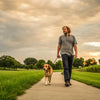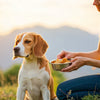How Long After Food Can a Dog Exercise: A Comprehensive Guide
- Houndsy
Table of Contents
- Introduction
- Understanding Canine Digestion
- The Risks Associated with Exercising After Eating
- Guidelines for How Long to Wait After Feeding Before Exercising
- Establishing a Balanced Feeding and Exercise Routine
- Conclusion
- Frequently Asked Questions (FAQs)
Introduction
As devoted pet owners, we often find ourselves balancing our dog's needs for nutrition and exercise. Have you ever wondered how long after food can a dog exercise? This question is more than just a matter of timing; it’s about ensuring the well-being of our furry friends. Recent studies indicate that allowing your dog adequate time to digest their food before engaging in physical activity can significantly reduce the risk of serious health issues, such as gastric dilatation-volvulus (GDV), commonly known as bloat.
In this blog post, we will explore the relationship between feeding and exercise, the risks associated with exercising immediately after meals, and practical tips to create a balanced routine for your dog. By the end of this article, we hope you will feel informed and empowered to make decisions that enhance your pet's health and happiness.
We will cover the following key areas:
- Understanding canine digestion and the effects of exercise on it.
- The risks associated with exercising after eating.
- Guidelines for how long to wait after feeding before exercising.
- Considerations based on breed, age, and health.
- Suggestions for establishing a balanced feeding and exercise routine.
So, let’s dive in and ensure that our dogs enjoy their meals and exercise safely!
Understanding Canine Digestion
When we feed our dogs, their digestive process begins almost immediately. Food is chewed and swallowed, traveling to the stomach, where it is broken down by digestive acids. This mixture then passes into the intestines for nutrient absorption, a process that can take anywhere from 6 to 10 hours depending on the dog's size, age, and diet.
The Role of Exercise in Digestion
While exercise is generally beneficial for dogs, its timing in relation to meals is crucial. Engaging in vigorous activities right after eating can disrupt the digestive process. Blood flow is redirected from the digestive tract to the muscles during exercise, which can slow down digestion and lead to discomfort or health issues.
Key Factors Influencing Digestion
- Type of Food: Dry kibble typically takes longer to digest than wet food. Understanding the type of food you provide can help determine how long you should wait before exercising.
- Dog's Size and Age: Larger breeds, especially those with deep chests, are more prone to issues like GDV. Puppies may have different digestion timelines compared to adults.
- Health Conditions: Dogs with pre-existing health issues may require more careful management of their feeding and exercise routines.
The Risks Associated with Exercising After Eating
Exercising immediately after meals can pose several risks. The most concerning is gastric dilatation-volvulus (GDV), a severe condition that can lead to bloating and stomach twisting. Some symptoms of GDV include:
- Swollen abdomen
- Restlessness or pacing
- Vomiting
- Excessive drooling
- Rapid breathing
If left unaddressed, GDV can be fatal. Thus, it's crucial to ensure our dogs have sufficient time to digest their food before engaging in any physical activity.
Other Risks of Immediate Exercise
- Bloating: Light exercise can lead to an accumulation of gas in the stomach, causing discomfort.
- Digestive Upset: Engaging in vigorous activities can lead to abdominal pain, cramping, or vomiting.
- Reduced Nutritional Absorption: When a dog is active right after eating, their body may struggle to absorb the nutrients efficiently.
Guidelines for How Long to Wait After Feeding Before Exercising
Knowing how long to wait after food before exercising can help avoid potential health risks. Here is a general guideline based on meal size:
- 30 minutes after a small snack
- 1 hour after a small meal
- 2 to 3 hours after a large meal
Individual Considerations
While these guidelines offer a solid foundation, it’s essential to tailor them based on your dog's specific needs:
- Breed: Larger breeds like Great Danes or German Shepherds may require longer waiting periods.
- Activity Level: Dogs that are more energetic may need more time to settle after meals.
- Health Concerns: Always consult your veterinarian if your dog has health issues that could affect digestion or exercise.
Establishing a Balanced Feeding and Exercise Routine
Creating a consistent routine for feeding and exercising can enhance your dog’s overall well-being. Here are some practical tips to consider:
- Regular Feeding Schedule: Feed your dog at the same times each day to establish a routine.
- Monitor Food Portions: Adjust food quantities based on your dog's activity level and weight, and consider feeding smaller meals more frequently.
- Calm Environment Post-Meal: After feeding, provide a quiet space where your dog can relax and digest their meal undisturbed.
- Hydration: Ensure your dog has access to fresh water, but avoid letting them drink excessively immediately after eating.
- Gentle Post-Meal Walks: If your dog enjoys a light walk after meals, keep it calm and leisurely to aid digestion without exerting them too much.
Conclusion
Understanding how long after food can a dog exercise is vital for maintaining your dog’s health. By adhering to the recommended waiting times and considering your dog's unique needs, you can help prevent serious health issues while ensuring they enjoy their meals and exercise safely.
As pet parents, it’s our responsibility to create routines that foster good health. We encourage you to reflect on your current feeding and exercise practices. How can you adjust them to enhance your dog’s well-being?
If you're looking for ways to elevate your pet feeding experience, consider exploring our innovative Houndsy Kibble Dispenser. With its beautiful design and ergonomic features, it simplifies the feeding process while ensuring your dog gets the right portions every time.
Frequently Asked Questions (FAQs)
Q1: Is it safe to walk my dog 30 minutes after eating?
While light walking may be safe for some dogs, it's generally recommended to wait at least one hour after a meal, especially for larger breeds.
Q2: What should I do if my dog engages in activity after eating?
If your dog is active after a meal, monitor them closely for signs of discomfort or distress. If you notice symptoms of GDV, seek veterinary care immediately.
Q3: How can I tell if my dog is bloated?
Signs of bloating include a swollen abdomen, excessive drooling, pacing, and signs of distress. If you suspect your dog is bloated, contact your veterinarian right away.
Q4: Can I feed my dog before or after a walk?
Feeding your dog after a walk is usually recommended, but if you feed them beforehand, ensure you allow sufficient time for digestion before engaging them in any vigorous activities.
Q5: What are the best feeding practices for my dog?
Stick to a consistent feeding schedule, provide appropriate portion sizes, and consider smaller, more frequent meals to aid digestion and prevent bloating.
By prioritizing your dog's health and following these guidelines, you can create a happy and healthy routine that enhances their life and yours.












